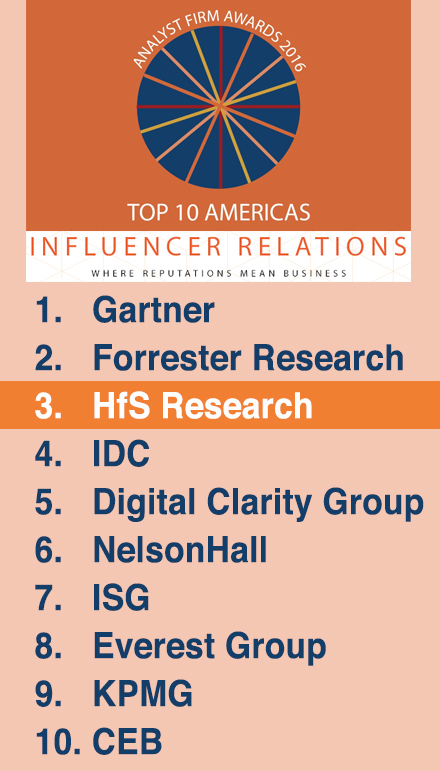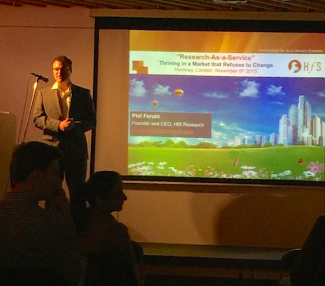Yes, I know I promised to savage anyone who used the term “uberize” to describe a disruptive business model, but having spent a fascinating day at the ARForum in London last week, it really struck me that uberization is pretty much what HfS has done to the traditional IT analyst industry, when you look at the results of what ~1000 consumers of IT research are saying:
While you can’t really do a direct apples-t0-apples comparison between the Uber and HfS business models, what we have in common is the fact we’ve both leveraged digital platforms to disrupt traditional, slow-moving industries – and with limited infrastructure and resources.
So why is HfS the “Uber” of the analyst industry?
1. We use digital technology, the web and social as our customer platform. At HfS, we do not need to hire armies of expensive, aggressive sales people to grow our customer base. We use our webplatform, a host of digital content and marketing apps, our blog and our social communities to bring the customers to us – at a fraction of the cost.
2. We don’t view “customers” as entities that have to give us money. Do Facebook, Twitter and LI fail to influence people because they are free? It’s the same with research – why does everyone have to pay money to be considered “influenced”. We get over a million visits to our stuff every year, well over 100,000 subscribers to our blogs and research and 15-20k pieces of research being downloaded each month. These are our customers. We just don’t believe in making everyone pay-to-play – we are of a size where we are proud to share what we do without slapping a huge paywall in front of the world. That’s why we are already the #3 firm in the industry in terms of reach and influence, after only 6 years in existence.
3. Freemium research, that is compelling and easy to access, is what gets read today. Most people tend to read only research when it’s slapped in front of them, that is digestible and compelling. Trying to navigate your way behind an expensively assembled firewall and search engine pretty much loses most people before they even think about trying to reset their password. I recall when I was last working for a “legacy” analyst firm that we were lucky to get more than 15 people downloading a report. Today we have in excess of 20,000 reading them. The difference is, simply, off the scale.
4. The revenue model is different from the incumbents. We don’t believe most people really want to pay for libraries of reports any more. They will, however, pay for benchmark and pricing data, competitive analyses and access to awesome analysts, who are fun to talk with and easy to get hold of. We also mix access to our massive global community (both physical and electronic) with the research access. Our buyer clients can come to our industry-leading quarterly summits, while vendor clients can have sponsorship privileges. We believe peer networking and sharing the dynamics of thousands of the global community as a critical part of the Research 2.0 process.
5. The customer experience is just so much better. I love the fact that, with Uber, both the drivers and customers get to rate each other. It’s a bit like that with HfS – we love our clients and we want them to love us. We do not put in 1-800 numbers to set up faceless analyst discussions, and we certainly do not stick analysts on competing postage-stamp P&Ls where they cover extremely narrow areas. In fact, talk to HfS and you’ll likely get a meeting with 4-5 of our analysts within a few days as so many areas are overlapping, if you really need to talk to us urgently. We also make time to hang out with our clients, at our office or theirs. We do this because we enjoy it, not because we just want to get through the ol’ 9-5 treadmill. It’s like getting into an Uber, where the driver is genuinely grateful to be of service, as opposed to some self-entitled miserable worker who’s just going through the motions.
6. The incumbents can’t/won’t cannibalize their revenues. No-one likes having to drop their prices, while improving their services and customer experience at the same time. It costs money and upsets investors with short-term mindsets. There is also an arrogance when your firm has been printing money for years, and suddenly you have to work for it again. Entitled people just do not want to work harder/smarter and with a better attitude. It’s the same for many of these overpriced creaking old taxis that smell like a dog died in the trunk – they simply have lost the ability and appetite to up their game.
The Bottom-line: It’s all about being non-traditional, using digital tech and creating a workable revenue model
Hopefully, after reading this, people will start to use the term “HfS-ize” instead of uberize =)
But, seriously, surviving in a market that refuses to change, such as the traditional IT analyst industry, is all about leveraging digital tech and the web to have a much, much more competitive model in terms of cost, reach and customer accessibility. However, you can use all the cool tech in the world, but it’s useless without the human factor to drive it and make the magic work. That’s where having a team of motivated, passionate – and genuinely nice people, makes this business successful.
While technology and a great business model is what makes the thing function, it’s really the people, the socially intelligent attitude and culture which make up our secret sauce.
Posted in : Business Process Outsourcing (BPO), Cloud Computing, CRM and Marketing, Design Thinking, Digital Transformation, HfSResearch.com Homepage, HR Strategy, IT Outsourcing / IT Services, Outsourcing Heros, SaaS, PaaS, IaaS and BPaaS, smac-and-big-data, Social Networking, sourcing-change, The As-a-Service Economy









Phil – fantastic article. Really sums up well how HfS has risen to be a leading analyst brand despite very established firms in a slow moving market. You should be very proud of what you and your team have achieved,
James Levy
This is such an amazing story of genuine disruption through quality and stealth – with a great sense of humor!
Well done and a great post,
Ramesh
Phil,
You tell a very interesting success story. What’s clear is that you can disrupt the analyst market with freemium model what you are small, but what happens when you need to scale the business? Isn’t this more of a short term play?
Graham
@Graham – it’s a smart question. We can probably grow HfS to about 50 analysts with the current model, which, in my opinion, is probably the optimum size for an analyst firm these days. So let’s get there first and they revisit what we need to do next =)
PF
It also shows that people are learning to pay on trust and not merely brand. As we have both said for years thing need to change but alas change isn’t automatic.
[…] Did HfS really just uberize the analyst business? – We use our webplatform, a host of digital content and marketing apps, our blog and our social communities … Twitter and LI fail to influence people because they are free? It’s the same with research – why does … […]
Repeat after me, “there’s no such thing as a free lunch”!
@mike… Maybe not. But there is some freemium research 🙂
I like your aggressive stance, but does the business model work? Or, like the ecommerce companies in India, are you after market share now and to hell with profitability?
Phil,
It’s been an incredible journey to observe for so many of us who’ve been reading your blog for so many years. Everyone talks about HfS these days with real irreverence – you’ve created a great brand.
Congratulations on this well deserved ranking!
Gaurav
Phil,
There are “Uber” examples in so many industries today, Airbnb, NetFlix, Amazon etc. HfS is definitely the Uber of analysts!
Ben Sharp
@Vijay – the business model most certainly works. We don’t have any investment or funding, so we need to sell first, then add more talent resources. This is the best way to build a knowledge business – you really don’t want the money guys involved until you reach a certain size / level of market maturity. We can feasibly grow HfS from its current stable of 15 senior analysts to 50, which we believe is about all a firm needs in today’s market. We would like to do more geographical expansion (especially Asia/Pac and Europe) as we evolve the business over the next couple of years.
But the financial model is dynamite – clients read the research and this whets their appetite to call us up to apply to their businesses. We have a highly scalable, accessible model that our clients love and is only getting better as we enhance and expand our team,
Cheers
PF
@Guarav – many thanks for the kind words. Was always a challenge to break out the HfS brand from my personal brand, but it’s great to have done it!
PF
Hi Phil,
Congrats on doing first degree of uberization of IT analyst business – introducing disruptive freemium research model on digital platform with minimum sales spend.
Whats your thinking on second degree of uberization – crowd sourcing of “research” from “grey hair industry execs” on your digital platform? (just like experienced drivers of own cars who became uber drivers). That would be really interesting to see if it takes off as “peer to peer IT consulting advisory services” where horses truly become sources…
Phil,
Great job on being the Uber for the Analyst Industry! An interesting next move would be to use the platform to allow other smart people to publish, distribute and perhaps monetize their research. University researchers, for instance, do a fantastic job in publishing serious research which is somehow buried on the internet.
Saludos,
Alex
Phil,
Congrats to the HfS team for getting in the top 3 list. As a Analyst Relations Manager, many of the things you mentioned resonate with me. I strongly believe that the analyst industry needs a disruption and happy to see that you guys are striving for that.
Best of luck!
Arjun